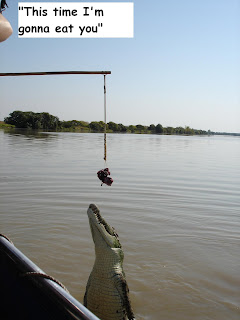My first day in Cairns was spent spending money, a whole lotta money, but as the blogs that will be coming your way over the next few weeks will show, it'll be worth it. My second day was spent on Palm Cove beach, relaxing, reading, getting a tan. After the busyness of the past few weeks and the even more busy next three weeks I needed a day to relax, so I did.
On my third day in Cairns I took a day trip to Cape Tribulation, where the Daintree Rainforest meets the beach. Cape Trib is a spectacularly beautiful place but, being 3hours away from Cairns, a little far to go on a day trip. We only got a 30 minute board walk through one part opf the Rainforest when we should have had more, that said I did enjoy the tour. The tour started with a nature cruise on the Daintree River before heading for the aforementioned walk and then lunch. After lunch it was beach time, but no swimming, couldn't be bothered with the whole drying myself afterwards, then the only other notable stop I remember was the ice cream place. Daintree Ice-cream is made on site, from locally produced fruit and only sold in that place in the whole world, well the sell worked on me, and I bought some - it was delicious.

Above, the road through the Daintree Rainforest
Below, where the rainforest meets the beach

My fourth day was spent on the Great Barrier Reef, and I have to say I was disappointed. Yes the Coral was amazing, the fish were multi coloured, and the ocean was amazingly clear, but at Ningaloo, on the other side of the continent, it was all that and more. Ningaloo just had something extra, it had a good tour. I paid $100 for my GBR tour and $130 for my Manta Ray and Ningaloo tour, and a got a whole lot more for $30 extra. At Ningaloo I got 3 guided snorkels, lots of information about the reef and it's inhabitants with around 11/2 hours in the water, at GBR I got 2 unguided snorkels and very little information (when I tried asking about turtles the guy I asked barely spoke English and didn't know much.) I was able to spend more time in the water at around 2 hours of swim time, this was split with an hour in each spot which was about half an hour too long. I was pretty disappointed, but I did manage to spot a turtle (with no help from the crew) and swam alongside it for 10 minutes - that made up for the poor tour.
My fifth and final in day around Cairns was spent in the touristy village of Kuranda getting back to nature with a visit to the Australian Venom Zoo - full with an array of scary, venomous or poisonous creatures that can kill you or your pet in 15 minutes. I also visited a Koala Zoo, where I fed Kangaroos again and after that walked for far too long to Barron Falls. A pretty good day, if too much walking.
Next stop: South to Mission Beach and white water rafting













